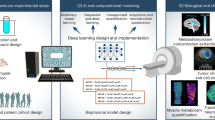Abstract
Magnetic Resonance Spectroscopy (MRS) is a non-invasive imaging technique based on nuclear magnetic resonance (NMR) principles. It analyzes the biochemical composition and metabolic processes of body tissues. Edited MRS Reconstruction converts raw MRS data into meaningful spectrum signals, providing valuable insights into cellular metabolism, organ function, and energy production. This process can help understand normal physiology, diagnose diseases, and monitor their progression. Additionally, it enables the extraction of metabolite concentrations, even when hidden by other biochemical compounds with higher concentrations (e.g., gamma-aminobutyric acid, glutamate, and glutamine). This study proposes a dual encoder head self-attention-based deep learning model to reconstruct the Edited MRS signal for acquiring GABA concentration and benchmark the model’s performance on simulated raw MRS data from real GABA-edited ground truths. Our model achieves a 95% decrease in Mean Squared Error (MSE), a 70% decrease in Linewidth, a 450% increase in Signal to Noise Ratio (SNR), and a 42% increase in Peak Shape Score compared to the current existing method on the test set. We also illustrate our qualitative results, demonstrating our method’s robust and accurate predictions compared to the ground truth. Our approach can help deliver rapid diagnosis and monitoring of neurological disorders, metabolic diseases, and certain types of cancers by providing refined and accurate data on metabolite concentrations.
Access this chapter
Tax calculation will be finalised at checkout
Purchases are for personal use only
Similar content being viewed by others
References
Allen, D.M.: Mean square error of prediction as a criterion for selecting variables. Technometrics 13(3), 469–475 (1971)
Badrinarayanan, V., Kendall, A., Cipolla, R.: SegNet: a deep convolutional encoder-decoder architecture for image segmentation. IEEE Trans. Pattern Anal. Mach. Intell. 39(12), 2481–2495 (2017)
Chan, K.L., Puts, N.A., Schär, M., Barker, P.B., Edden, R.A.: HERMES: Hadamard encoding and reconstruction of mega-edited spectroscopy. Magn. Reson. Med. 76(1), 11–19 (2016)
Cohen, I., et al.: Pearson correlation coefficient. In: Noise reduction in speech processing. Springer Topics in Signal Processing, vol. 2, pp. 1–4. Springer, Heidelberg (2009). https://doi.org/10.1007/978-3-642-00296-0_5
Di Costanzo, A., et al.: Proton MR spectroscopy of the brain at 3 T: an update. Eur. Radiol. 17, 1651–1662 (2007)
He, K., Zhang, X., Ren, S., Sun, J.: Deep residual learning for image recognition. In: Proceedings of the IEEE Conference on Computer Vision and Pattern Recognition, pp. 770–778 (2016)
Huang, S., Wang, D., Wu, X., Tang, A.: DSANet: dual self-attention network for multivariate time series forecasting. In: Proceedings of the 28th ACM International Conference on Information and Knowledge Management, pp. 2129–2132 (2019)
Iqbal, Z., Nguyen, D., Thomas, M.A., Jiang, S.: Deep learning can accelerate and quantify simulated localized correlated spectroscopy. Sci. Rep. 11(1), 8727 (2021)
Johnson, D.H.: Signal-to-noise ratio. Scholarpedia 1(12), 2088 (2006)
Kaiser, L., Young, K., Meyerhoff, D., Mueller, S., Matson, G.: A detailed analysis of localized J-difference GABA editing: theoretical and experimental study at 4 T. NMR Biomed. Int. J. Devoted Develop. Appl. Magn. Reson. In vivo 21(1), 22–32 (2008)
Kumar Reddy, A.N., Sagar, D.K.: Half-width at half-maximum, full-width at half-maximum analysis for resolution of asymmetrically apodized optical systems with slit apertures. Pramana 84, 117–126 (2015)
Mescher, M., Merkle, H., Kirsch, J., Garwood, M., Gruetter, R.: Simultaneous in vivo spectral editing and water suppression. NMR Biomed. Int. J. Devoted Develop. Appl. Magn. Reson. In Vivo 11(6), 266–272 (1998)
Mikkelsen, M., Loo, R.S., Puts, N.A., Edden, R.A., Harris, A.D.: Designing GABA-edited magnetic resonance spectroscopy studies: considerations of scan duration, signal-to-noise ratio and sample size. J. Neurosci. Meth. 303, 86–94 (2018)
Nagi, J., et al.: Max-pooling convolutional neural networks for vision-based hand gesture recognition. In: 2011 IEEE International Conference on Signal and Image Processing Applications (ICSIPA), pp. 342–347. IEEE (2011)
Nussbaumer, H.J., Nussbaumer, H.J.: The fast Fourier transform. In: Fast Fourier Transform and Convolution Algorithms. Springer Series in Information Sciences, vol. 2, pp. 80–111. Springer, Heidelberg (1981). https://doi.org/10.1007/978-3-642-81897-4_4
O’Shea, K., Nash, R.: An introduction to convolutional neural networks. arXiv preprint arXiv:1511.08458 (2015)
Petroff, O.A.: Book review: GABA and glutamate in the human brain. Neuroscientist 8(6), 562–573 (2002)
Puts, N.A., Edden, R.A.: In vivo magnetic resonance spectroscopy of GABA: a methodological review. Prog. Nucl. Magn. Reson. Spectrosc. 60, 29 (2012)
Ronneberger, O., Fischer, P., Brox, T.: U-Net: convolutional networks for biomedical image segmentation. In: Navab, N., Hornegger, J., Wells, W.M., Frangi, A.F. (eds.) MICCAI 2015. LNCS, vol. 9351, pp. 234–241. Springer, Cham (2015). https://doi.org/10.1007/978-3-319-24574-4_28
Saleh, M.G., et al.: Simultaneous edited MRS of GABA and glutathione. Neuroimage 142, 576–582 (2016)
Szegedy, C., Ioffe, S., Vanhoucke, V., Alemi, A.: Inception-v4, inception-ResNet and the impact of residual connections on learning. In: Proceedings of the AAAI Conference on Artificial Intelligence, vol. 31 (2017)
Tao, W., et al.: EEG-based emotion recognition via channel-wise attention and self attention. IEEE Trans. Affect. Comput. (2020)
Vaswani, A., et al.: Attention is all you need. In: Advances in Neural Information Processing Systems, vol. 30 (2017)
Wang, Y., Yang, G., Li, S., Li, Y., He, L., Liu, D.: Arrhythmia classification algorithm based on multi-head self-attention mechanism. Biomed. Signal Process. Control 79, 104206 (2023)
Wei, S., Qu, Q., Zeng, X., Liang, J., Shi, J., Zhang, X.: Self-attention Bi-LSTM networks for radar signal modulation recognition. IEEE Trans. Microw. Theory Tech. 69(11), 5160–5172 (2021)
Willmott, C.J., Matsuura, K.: Advantages of the mean absolute error (MAE) over the root mean square error (RMSE) in assessing average model performance. Clim. Res. 30(1), 79–82 (2005)
Yang, X., Zhao, J., Sun, Q., Lu, J., Ma, X.: An effective dual self-attention residual network for seizure prediction. IEEE Trans. Neural Syst. Rehabil. Eng. 29, 1604–1613 (2021)
Author information
Authors and Affiliations
Corresponding author
Editor information
Editors and Affiliations
Rights and permissions
Copyright information
© 2023 The Author(s), under exclusive license to Springer Nature Switzerland AG
About this paper
Cite this paper
Sagar, D., Mohammadi, F., Pourhomayoun, M., Joen, J., Amini, N. (2023). Deep Learning Based GABA Edited-MRS Signal Reconstruction. In: Bebis, G., et al. Advances in Visual Computing. ISVC 2023. Lecture Notes in Computer Science, vol 14361. Springer, Cham. https://doi.org/10.1007/978-3-031-47969-4_2
Download citation
DOI: https://doi.org/10.1007/978-3-031-47969-4_2
Published:
Publisher Name: Springer, Cham
Print ISBN: 978-3-031-47968-7
Online ISBN: 978-3-031-47969-4
eBook Packages: Computer ScienceComputer Science (R0)




